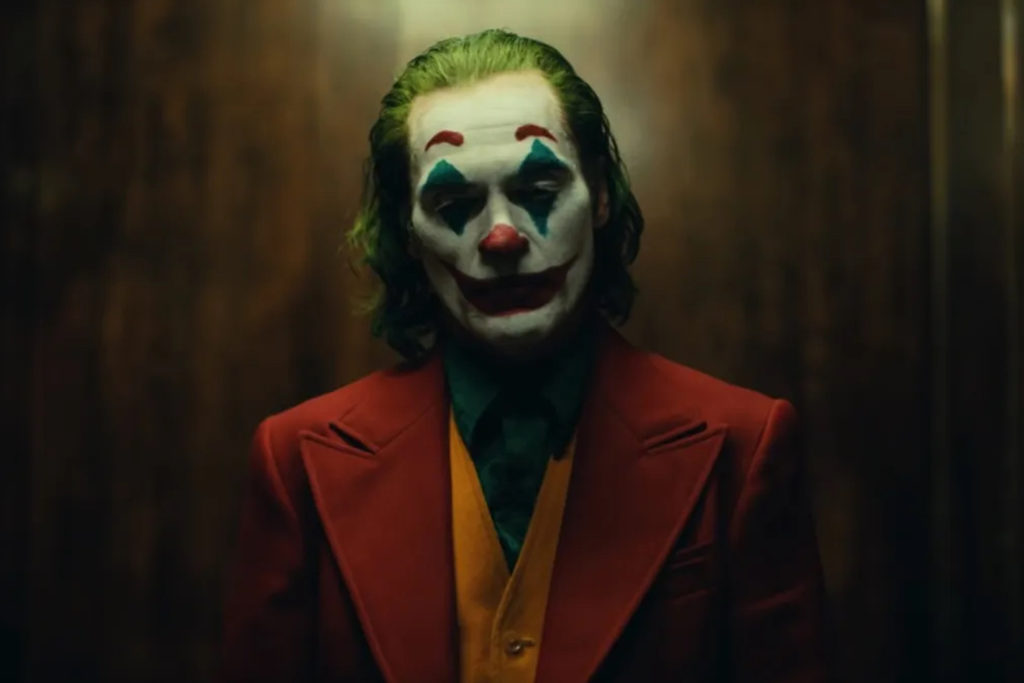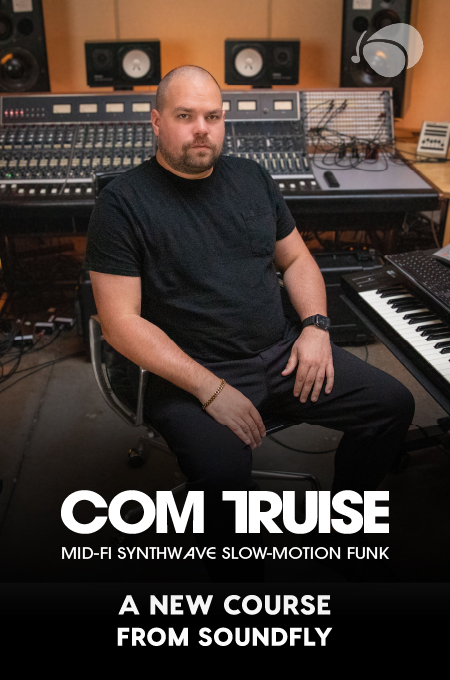
+ New course on Soundfly: Intro to Scoring for Film & TV is a full-throttle plunge into the compositional practices and techniques used throughout the industry, and your guide for breaking into it.
Hildur Guðnadóttir’s score for Joker (2019) is primarily a study of timbre, dissonance, and simple intervals. It evokes a darkness and uneasiness that is fundamentally rooted in primal chord construction and the inherent strangeness evoked by a minor third. It also helps to position Joker as a spiritual prequel — not to Robert Pattinson’s recent portrayal of Batman, but rather to Christopher Nolan’s Dark Knight trilogy: Batman Begins (2005), The Dark Knight (2008), and The Dark Knight Rises (2012).
Obviously there’s no universe in which Joaquin Phoenix turns into Heath Ledger. Their performances — while both the work of true masters — are completely distinct. But the nihilism at the heart of the Joker’s worldview which is on full display in The Dark Knight is more fully elucidated in the film Joker by framing it in the context of the very real struggles surrounding poverty, social alienation, and mental illness.
And it is Joker’s music which helps draw the connection between the two films.
I will say at the outset that this is my interpretation of the music and the thematic connections between Hildur Guðnadóttir’s score for Joker and Hans Zimmer and James Newton Howard’s scores for The Dark Knight trilogy. I’ve read and watched several interviews with Guðnadóttir and have not heard her express an explicit inspiration from Zimmer and Howard’s work. That said, the musical homage seems to me to be intentional, or at the very least a kind of cosmic elegance.
Hildur Guðnadóttir

Composer Hildur Guðnadóttir is an Icelandic cellist whose name means “War Daughter of God.” You may have heard her cello performance in the late Jóhann Jóhannsson’s scores, such as Sicario (2015) and Arrival (2016). She’s gone on to have a composition portfolio that includes Sicario: Day of the Soldado (2018) and the HBO miniseries Chernobyl (2019), with the score for the latter recorded in an actual nuclear power plant.
In composing the score for Joker, Guðnadóttir had the rare opportunity to begin writing the music before filming started. Director Todd Phillips has said, “To me, the music is one of the biggest characters of the film.” And he clearly meant it. He sent Guðnadóttir the script before shooting and as she composed she would send Phillips recordings of music inspired by the character of Arthur Fleck (i.e. Joker). She deeply empathized with Arthur’s struggle, saying in an interview:
“He’s trying to actually bring joy to the world, and just doesn’t really succeed because of outer circumstances that really affect his inner turbulence. I was just really sympathetic towards that. It’s very tragic. So, I thought it was important that he was allowed to kind of have this softer side.”
+ Read more on Flypaper: “How Jonny Greenwood Uses Materiality, Clusters, and Aleatoricism in His Film Music.”
The Dancing Clown
That softer side is beautifully expressed in the first piece Guðnadóttir composed for the film, which was later titled “Bathroom Dance.”
This piece acts as a theme for the Joker throughout the film. A solo cello repeats two notes that form a minor third, mournfully playing C# and E over and over. Slowly, harmonies are added, then later a choir, then finally a full orchestra with percussion joining the mournful dirge, foreshadowing the operatic heights that the score will reach by the end of the film.
The simplicity of the repeated minor third in “Bathroom Dance” seems to articulate the primal anguish of Arthur’s sadness begging to be heard. Arthur has real trauma in his past, and the story of Joker is ultimately Arthur’s journey to find an outlet for the emotions that have been stifled and framed as “negative” (anger, sadness, grief) after he was repeatedly told growing up that he “had a purpose to bring laughter and joy to the world.”
This coming from a mother who suffers from narcissistic personality disorder, allowed him to be horrifically abused by her boyfriends, and now refuses to call Arthur anything other than the nickname “Happy.”
Guðnadóttir sent this piece of music to Todd Phillips who played it for Joaquin Phoenix on his iPhone while they were trying to figure out the blocking for a scene that takes place in a dingy bathroom after Arthur has committed his first murders. Listening to the music, Phoenix began dancing. After a moment, Phillips and Phoenix looked at each other and said, “Okay. That’s the scene.” This ended up elevating the scene from a simple reflection on the killings that had just taken place into an embodied expression of Arthur’s transformation into Joker.
Following this interaction between Todd Phillips and Joaquin Phoenix, the crew regularly piped Guðnadóttir’s music into their earpieces while shooting the film.
+ Read more on Flypaper: “The Cutting Edge: 10 Film Scores That Push the Boundaries of Composition.”
Before Batman Begins
The parallels to Zimmer and Howard’s score begin with “Bathroom Dance.” From the very first moments of Batman Begins we hear the trilogy’s main theme expressed: a minor third. Similar to other comic book movie tropes that were subverted by that film, the score is one of the first in the “superhero” genre to focus on simple motifs rather than hummable melodies. The composers felt that pretty, memorable melodies would distract from the depth of the characters being developed.
In this case (“Vespertillo”), the minor third is drawn out in long heroic notes by the brass section rather than a cello, and starts on D rather than C#. But the focus on a non-melodic figure, centered around only two notes that form a minor third makes these two themes deeply connected.
The intertextuality reminds me of the thrill I got when I first heard how Shirley Walker deconstructed and transformed Danny Elfman’s classic Batman theme into something completely new and beautiful in Batman: Mask of the Phantasm.
Steven Rahn extensively analyzed the minor third’s usage in the Dark Knight Trilogy as it is reharmonized from the minor tonic (i-i progression), to a i-VI progression in moments of empowerment and triumph, to a i-VII progression when ethical dilemmas arise. This technique of reharmonization is used in a compressed form in “Bathroom Dance” to provide depth and new connotations to the simple, unchanging notes.
The ponticello timbre used by Guðnadóttir in pieces like “Looking For Answers” and “Confession” seems to be a direct reference to Joker’s theme from The Dark Knight (“Why So Serious?”), though in the latter case the effect was achieved partly with razor blades on the strings.
There’s also a percussive “ticking” sound created with a col legno effect that occurs throughout the Joker score (“Subway,” “Escape from the Train,” “Call Me Joker”). This feels like a reference to the ticking that recurs several times in The Dark Knight (“Why So Serious?,” “I’m Not a Hero”).
In the context of Joker, this ticking seems to measure the inevitable passage of time as the timebomb that is Arthur reaches his breaking point. Measuring the time until Penny Fleck’s death. Until Murray Franklin’s death. The death of civility. The death of democracy. The death of honor and heroes.
Music Tells the Story
Guðnadóttir’s score is by no means unoriginal. On the contrary, it is richly orchestrated with many unique and engaging moments. “Defeated Clown,” for instance, is beautifully tender and evocative. It plays at the end of the film’s opening sequence as Arthur is beaten up by teenagers. The harmony of the strings — withheld for so much of the rest of the film — brings out our sympathy for Arthur’s plight and his desire to be loved and accepted.
This same theme is later developed to great effect when Arthur breaks into Sophie’s apartment (“Arthur Comes To Sophie”). The menacing cello rings out the “Defeated Clown” theme, punctuated by the pounding of deafening digital and acoustic percussion. It’s in this moment that we get empirical confirmation that Arthur is delusional.
That — beyond just having daydreams of someday being interviewed on a late night TV show — he has truly been fabricating entire relationships with other people. The neighbor who we’ve perceived up until this point as his only friend in the entire world, actually knows nothing about him beyond his name and the fact that he lives with his mother. It is in this moment that we see that Arthur is truly and irreparably alone.
The whispering ponticello bowing in “Young Penny” is heart-breaking, especially when paired with the horrors we hear of Arthur’s early childhood. The quiet restraint exhibited by the performers in this piece recalls the “Adagietto” from Mahler’s Symphony No 5.
In a score so full of moments of quiet chaos reminiscent of György Ligeti, “Call Me Joker” is notable for the mournful, Wagnerian orchestration that emerges around the 3-minute mark, with themes morphing and interweaving with each other in ever-intensifying dramatic fervor.
+ Read more on Flypaper: “György Ligeti’s ‘Musica Ricercata’: Is It Possible to Compose with Just One Note?”
Diegetic and Soundtrack Music
Going beyond the score, Randall Poster acted as music supervisor for the film, advising on the additional songs that would be included. We often hear diegetic music playing within the world of Joker. When the character Randall first gives Arthur a gun, we hear “Everybody Plays the Fool” (1972) by The Main Ingredient quietly playing in the locker room.
Arthur later dances in a children’s hospital to a ridiculously saccharine version of “When You’re Happy and You Know It” performed by Chaim Tannenbaum. It’s a particularly apt song choice, given the complexity of Arthur’s nickname, “Happy,” his later statement that “I haven’t been happy one minute of my entire fucking life,” and the fact that he drops the gun in this scene and gets fired from his job.
One of the investment bankers on the train sings a haunting unaccompanied rendition of “Send in the Clowns” while lights flicker and he taunts Arthur before he and his friends kick him repeatedly — an act that provokes Arthur to murder all three of them.
Multiple versions of “That’s Life” play throughout the film. An instrumental version is used as the outro music for the Murray Franklin Show, which we hear as Arthur dances with his mother. And the audience hears this play at key points in the film such as when Joker dyes his hair green or in the asylum during the final scene before the credits.
And, of course, there’s the controversial usage of “Rock and Roll, Part 2” by Gary Glitter, where we first see the clown prince of crime celebrate his transformation in full regalia.

Descent Into Madness
In key scenes, music is notably absent, like when a full 40 seconds of screentime is spent on Arthur suffocating his mother with a pillow, with only the sounds of her muffled cries and the beeping of her cardiac monitor to accompany it.
Abandoned by his birth parents; abandoned by his coworkers who ridicule him; abandoned by the American dream of success, and by a crumbling mental health system that drops him when he most needs his medication. After Arthur kills his mother, he has severed all human connection to the world. He’s lost everything. He later states, “Nothing can hurt me anymore,” and it’s clear that he means this literally — he has experienced pain beyond anything someone could inflict on him. There is nothing to hold back his anger and megalomania. Arthur has fully become Joker.
The score in the film’s last half hour follows Joker as he simultaneously falls deeper into insanity and elevates in power and influence.
The piece “Escape From The Train” begins with frenetic tapping and clanging to accompany the chase sequence as Arthur evades detectives by stealing a joker mask and blending in with all the other people protesting wealth inequality. He leaves riotous violence in his wake and is comfortably shielded from pursuit.
As he exits the subway, we hear a reprise of the dark haunting tones of “Meeting Bruce Wayne” as Arthur embodies the full brazen confidence of Joker, casually smoking a cigarette while police run oblivious in the opposite direction.
The law is a joke. The power of the raw rage that Arthur has brought out of the poverty of Gotham is now clearer than ever. Joker walks directly from the scene of a murder onto the set of a late night television show.
Joker dances onto the stage to the tune of an upbeat jazz version of the Charlie Chaplin song “Smile.” Before sitting down, he — without consent — kisses Dr. Sally Friedman (clearly a stand-in for popular real-world psychologists like Dr. Joyce Brothers). After some banter back and forth, Murray Franklin asks his strange, clown-garbed guest the question we’ve been waiting for, “Do you want to tell us a joke?”
We hear a deep bass tone, the drumming of the timpani, and dissonant strings as Joker flips through his journal (a prop likely inspired by Heath Ledger’s own Joker diary). He glances across the phrase “I hope my death makes more cents than my life.” We relax back into Joker’s carefree confidence, but tragic strings return to underscore his confession that he killed the Wall Street bankers in the subway (“Confession”).
A rhythmic clanging ramps up in the score as Joker tells one more joke, “What do you get when you cross a mentally ill loner with a society that abandons him and treats him like trash? You get what you fucking deserve.” Joker shoots Murray Franklin in the head, the audience panics, and Arthur approaches the camera to say, “Goodnight. And always remember: That’s L—” cut off before he can say, “That’s Life.”
Instead of “That’s Life,” the screen cuts to the placeholder Indian-head test pattern and we hear the absurdly peppy tones of “Spanish Flea” by Herb Alpert and the Tijuana Brass, best known as the theme music for The Dating Game. We zoom out to see a wall of televisions, all sensationalizing the violence of Joker killing Murray Franklin, amplifying his message. The “if it bleeds it leads” strategy of news media is here shown to be directly complicit in inciting Gotham to mass panic. It’s not too much of a stretch to see a parallel here to the role that the media played in getting certain other jokers in our world elected to executive power.
Back on the streets, Cream’s “White Room” plays as Gotham riots and the city is set ablaze by clowns. Joker’s modus operandi is chaos, and we see that unbridled chaos consuming the city. “Isn’t it beautiful,” he remarks as he literally watches the world burn — perhaps another subtle throwback to The Dark Knight. The police car carrying him is hit by an ambulance operated by rioters in clown masks. He is taken out of the car and splayed on the hood.
In the film’s dramatic climax, Arthur slowly stands and spreads his own blood across his lips and cheeks in a grueling smile as he dances and poses on top of the demolished police car that he and his army of jokers has conquered. He finally has the attention and adoration he’s been longing for his entire life. And the orchestra sings out the operatic tragedy in reply (“Call Me Joker”).
The denouement plays out in Arkham Asylum, as Joker laughs in contemplation of “a joke” — the death of Bruce Wayne’s parents. An orchestra of quiet, dissonant strings brings us the thematic return of a single note just slightly off-pitch.
This ending hearkens to all that is to come in The Dark Knight trilogy. We see Joker walking and dancing down Arkham’s sunlit hallway, leaving a trail of bloody footsteps in his wake. He’s killed his therapist (at least in his mind), and as he runs from the asylum guards in the neverending chase, Frank Sinatra sings the brazen finale to “That’s Life:” “I’m gonna’ roll myself up in a big ball and die. My, my.”
In Closing
There are many who would totally disregard Joker as a dangerous film (there’s certainly been controversy, and it’s already been used as an excuse for a real murder). There are still others who would see it as justification for their own pessimistic, misanthropic worldview. I hope that we, as viewers, can place it somewhere in the middle. The issues raised in the film are very real (wealth inequality, an underfunded mental health system, deep alienation from our own communities, etc.), but Joker’s anti-society, “watch the world burn” solution is obviously an immature, desperate, and tragic outcome.
Hopefully, Joker can be the lens by which we reflect on the rage brewing in the heart of America right now and take inspiration to do better for all of our citizens.
And as for the music: Was Hildur Guðnadóttir inspired by the work of Hans Zimmer and James Newton Howard? I have no idea. It seems fair to assume that she had heard their scores. But it may very well be that Zimmer and Howard’s work has simply impacted the world of cinema to such a degree that this is just “what movies sound like now.”
Or it may be that Guðnadóttir just liked Ligeti and Wagner and thought a minor third was a nice creepy interval to play with.
Regardless, the score to Joker is masterful, and certainly motivated me to revisit and relish in its 2008 precursor, The Dark Knight.
—
Note: If you’re curious, TuneFind has a great rundown of every major musical moment of the film.
Don’t stop here!
Continue learning with hundreds of lessons on songwriting, mixing, recording and production, composing, beat making, and more on Soundfly, with artist-led courses by Kimbra, Com Truise, Jlin, Kiefer, and the new Ryan Lott: Designing Sample-Based Instruments.



